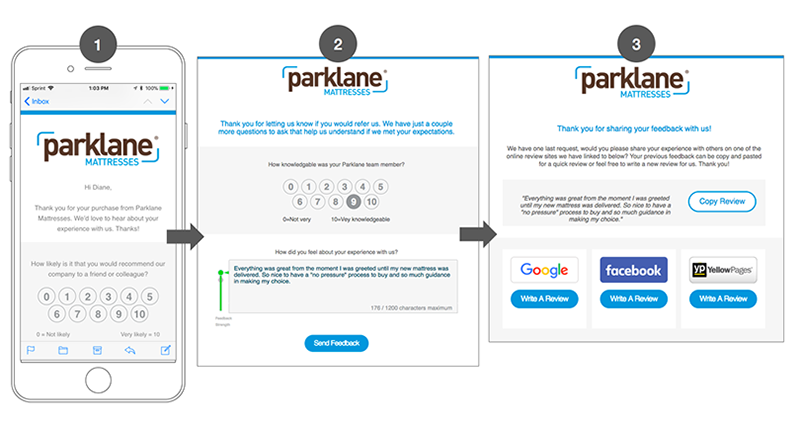REVU offers three Request Modes to easily capture feedback and reviews from your customers. This guide explains the capabilities of each request mode so you can understand which one is right for your business.
- Ultimate Mode
- Review Mode
- Direct Mode
Ultimate Request Mode

Ultimate Request Mode is a 3-step process for your customer so that you can quickly capture complete customer experience data for your business including:
- Net Promoter Score
- Optional Survey Questions
- Customer feedback (1st-party review/testimonial)
- Reviews on 3rd-party sites (choose 2-4 sites)
Net Promoter Score
The Net Promoter Score is based on a response to this question:
How likely is it that you would recommend (your company/product/service) to a friend or colleague?
Customers select a rating of 0-10 with 0=Not likely and 10=Very likely and fall into one of the following categories:
Promoters (9-10): Likely to buy more, remain a customer for longer and make more positive referrals to other potential customers.
Detractors (0-6): Less likely to have positive buying and referral behaviors
Passives (7-8): Behavior falls between Promoters and Detractors.
The objective of NPS is to predict customer loyalty and claims to be correlated with revenue growth.
Optional Survey Questions
Ask your customer up to 4 additional questions using a 0-10 rating scale to gather more specific information than what the Net Promoter Score provides. It’s easy to add optional survey questions to Ultimate Mode.
Customer Feedback (1st-party Review/Testimonial)
Request customer feedback using Ultimate Mode to help you understand your customer’s experience and alert you of issues that need follow-up.
You can also use customer feedback as a 1st-party Review/Testimonial. Display these reviews on your website and add valuable schema to impact SEO using available widgets.
Reviews on 3rd-party Sites
Request 3rd-party reviews from your customers. Choose up to 4 sites from over 100 online review sites, such as Google and TripAdvisor, to include in your request.
A 3-Step Process for Your Customer
Step 1: Send a feedback request to your customer via email.
- For email requests, customers select a Net Promoter Score rating in the email that links them to Step 2.
Step 2: A landing page is served that includes up to four optional survey questions and an open text field to generate customer feedback and 1st-party reviews (testimonials).
Step 3: After submitting feedback, customers are served a page that includes links to selected 3rd-party review sites. As a result of the rating received, a positive or negative page version is served.
Customer can also access the Ultimate Request Mode using TextBack, Feedback Locator, or Feedback URL.
Review Request Mode

Review Request Mode is a 2-step process to request:
- Net Promoter Score
- Reviews on 3rd-party sites (choose 2-4 sites)
2-Step Process for your Customer
Step 1: Send a feedback request to your customer via email.
- For email requests, customers select a Net Promoter Score rating in the email that links them to Step 2.
Step 2: After selecting an NPS rating, customers are served a page that includes links to selected 3rd-party review sites. As a result of the rating received, a positive or negative page version is served.
Customers can also access the Ultimate Request Mode using Feedback Locator, or Feedback URL.
Direct Request Mode

Direct Request Mode is a 1-step process to request:
- Reviews on 3rd-party sites (choose 2-4 sites)
Because Direct Mode gives customers direct access to your online review profiles we recommend only businesses with a known NPS over 80 consider using Direct Mode.
1-Step Process for your Customer
Step 1: Send a feedback request to your customer via email.
- For email requests, customers select an online review profile to then leave a review.
Customer can also access Direct Request Mode using Feedback Locator, or Feedback URL.
